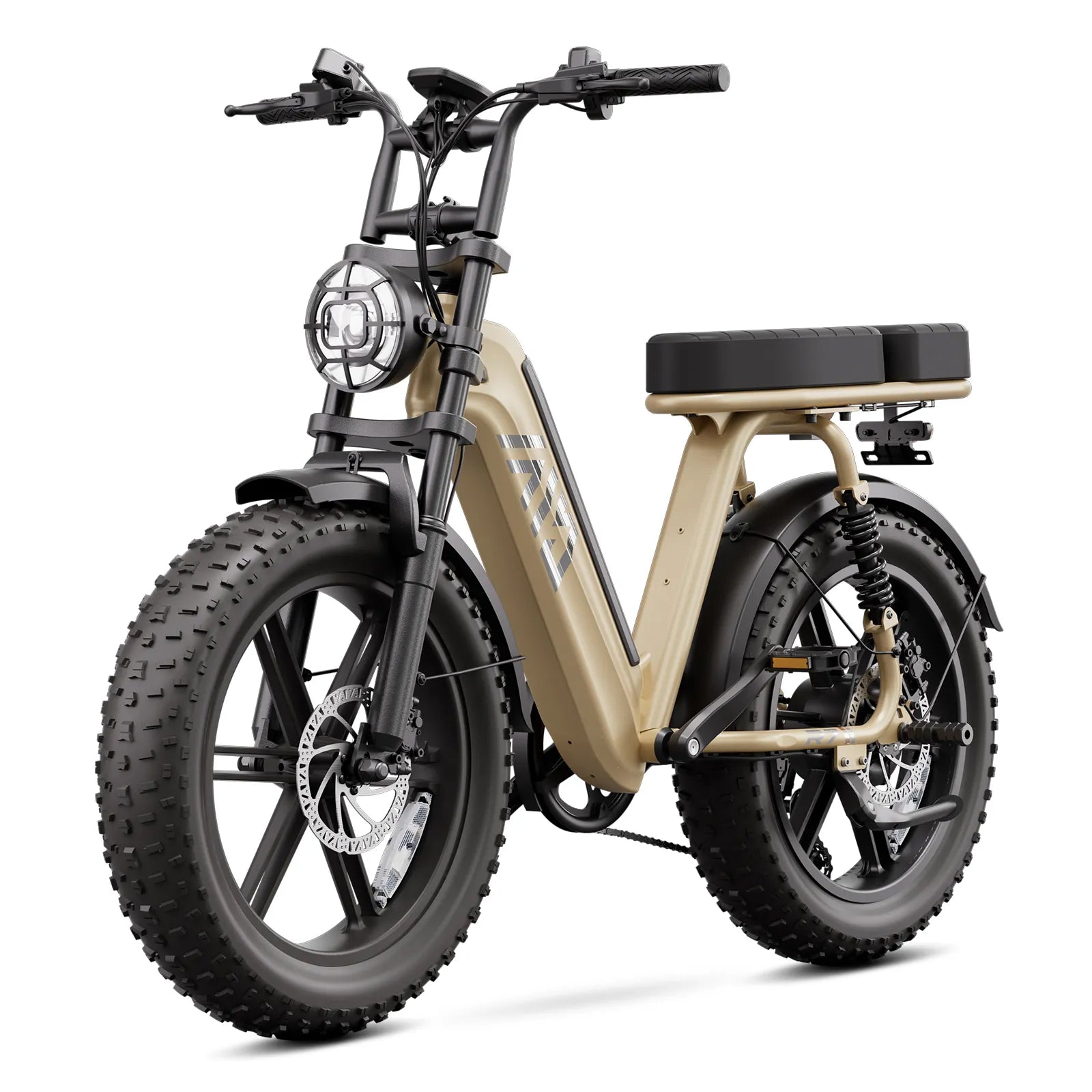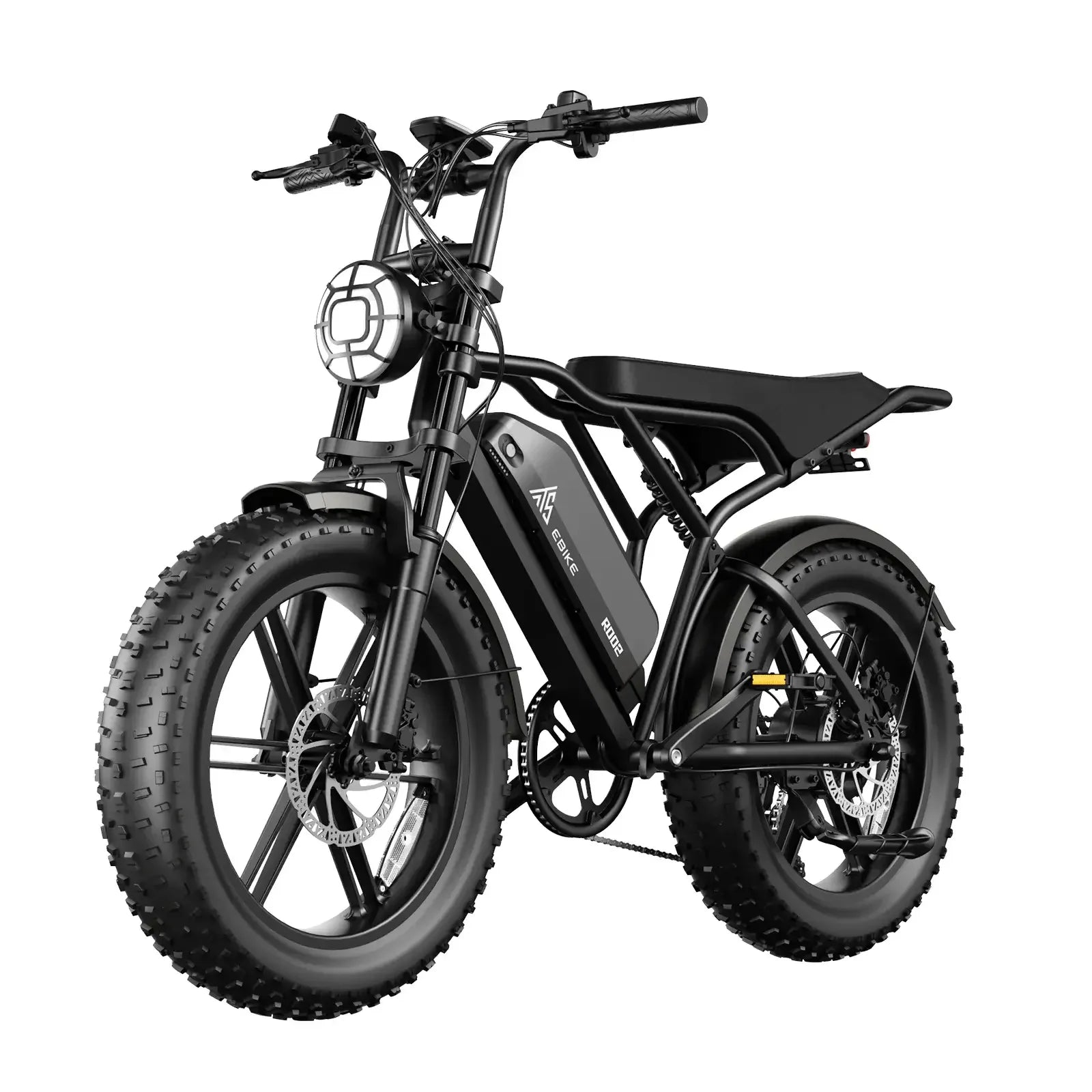A 28MPH fat tire electric bike is powered by a high-wattage brushless motor, typically ranging from 750W to 1300W peak power, paired with a 48V 15Ah lithium-ion battery. This combination delivers strong torque and sustained energy, enabling rapid acceleration, hill climbing, and maintaining speeds up to 28 miles per hour while providing excellent traction and stability on diverse terrains.
How Does Motor Power Enable a Fat Tire Ebike to Reach 28MPH?
Motors rated between 750W and 1300W provide the necessary torque—often between 70Nm and 85Nm—to propel fat tire ebikes to speeds of 28MPH. High wattage motors deliver rapid acceleration and maintain consistent power output even on hills or rough terrain. Brushless gear motors are common for their efficiency, durability, and quiet operation, ensuring smooth performance at higher speeds.
Chart: Motor Power and Torque for 28MPH Fat Tire Ebikes
| Motor Power (W) | Torque (Nm) | Typical Top Speed (MPH) | Common Use Cases |
|---|---|---|---|
| 750W | 70 | 20-28 | Urban commuting, light off-road |
| 1000W-1300W | 85 | 28 | Heavy-duty, off-road, hill climbing |
A fat tire e-bike can go as fast as 28 miles per hour mainly because of its strong electric motor. When a motor produces between 750 and 1300 watts, it generates enough torque—the twisting force that turns the wheels—to move the heavy frame and wide tires quickly, even on hills or uneven ground. This power allows the bike to accelerate smoothly and maintain steady speed without losing strength on rough terrain.
Most models, including those from TST EBike, use brushless gear motors that run quietly and last longer. These motors are efficient, meaning they use electricity wisely while providing high performance. Riders with a 750W motor can handle city commutes comfortably, while 1000W or higher motors are ideal for off-road trails and steep climbs. The balance of power, torque, and tire design makes these e-bikes fast, reliable, and fun to ride.
What Role Does the Battery Play in Powering a 28MPH Fat Tire Ebike?
A 48V 15Ah lithium-ion battery is standard for powering 28MPH fat tire ebikes, offering a balance of voltage and capacity to sustain high speeds and long ranges—often up to 60-65 miles on pedal assist. The battery’s voltage ensures sufficient power delivery to the motor, while the amp-hour rating determines how long the ebike can maintain top speeds before recharging is needed. How Do Fat Tire Electric Bikes Handle Snow?
Which Features Complement the Motor and Battery for Optimal Performance?
Optimal performance of an ebike depends on features like high-quality controllers, efficient regenerative braking, and reliable pedal-assist sensors. Durable suspension systems improve ride smoothness, while lightweight frames enhance maneuverability. Quality tires with good traction reduce rolling resistance. Additionally, smart displays provide real-time battery and speed info, helping riders manage power use effectively. Together, these features ensure the motor and battery work efficiently, maximizing range, power delivery, and overall ride comfort.
Key components that enhance the powertrain include:
- Efficient torque and speed sensors for responsive pedal assist.
- Hydraulic disc brakes for reliable stopping power at high speeds.
- Wide 26” or 27” fat tires (4 inches or wider) providing traction and stability.
- Durable aluminum or chromoly steel frames to handle motor torque and rider weight.
- Quality controllers managing power output and protecting battery health.
These features ensure that the ebike performs safely and efficiently at 28MPH.
How Do Fat Tires Affect the Riding Experience at 28MPH?
Fat tires increase ground contact, improving grip and shock absorption on snow, sand, and rough trails. At 28MPH, this enhanced traction provides stability and confidence, reducing the risk of slipping during acceleration or cornering. Their ability to run at lower tire pressures cushions the ride, making high-speed travel more comfortable and controlled.
Why Are TST EBike’s Models Notable for 28MPH Fat Tire Performance?
TST EBike’s fat tire models feature 1300W brushless gear motors paired with 48V 15Ah batteries, delivering up to 28MPH top speeds and ranges of 65 miles. Their 26” x 4” puncture-resistant fat tires offer superior traction on rugged terrain, while hydraulic disc brakes ensure safe stopping. Built with durable frames and designed from consumer feedback, TST EBike balances power, reliability, and affordability.
Buying Tips
When purchasing a 28MPH fat tire electric bike, consider:
- Motor wattage (at least 750W, preferably up to 1300W) for sustained high speeds.
- Battery voltage and capacity (48V 15Ah or higher) for range and power consistency.
- Tire size and width (26” or 27” fat tires, 4 inches or wider) for stability.
- Braking system quality, favoring hydraulic disc brakes for safety.
- Frame durability and weight capacity to handle motor torque and rider load.
- Presence of torque sensors and quality controllers for smooth power delivery.
Test rides and checking manufacturer specifications ensure the bike meets your speed and terrain needs.
TST EBike Expert Views
“TST EBike’s 28MPH fat tire models combine powerful 1300W motors with high-capacity 48V 15Ah batteries and wide, durable tires to deliver thrilling performance and dependable range. Our hydraulic disc brakes and reinforced frames provide the control and safety riders demand at higher speeds, making these ebikes versatile for urban and off-road adventures.” – TST EBike Product Specialist
FAQ
What motor power is needed for a 28MPH fat tire ebike?
Motors between 750W and 1300W peak power typically achieve 28MPH speeds.
How long does the battery last at 28MPH speeds?
A 48V 15Ah battery can provide 60-65 miles of range, depending on terrain and assist level.
Are fat tires necessary for stability at 28MPH?
Yes, fat tires improve traction and shock absorption, enhancing stability at higher speeds.
What type of brakes are best for 28MPH fat tire ebikes?
Hydraulic disc brakes offer the most reliable stopping power and modulation at these speeds.
Is 28 mph fast on an eBike?
Yes, 28 mph is considered fast for an eBike, corresponding to Class 3 eBikes which provide pedal-assist up to this speed. It’s significantly quicker than most Class 1 and 2 eBikes capped at 20 mph, making 28 mph ideal for commuters who want speed combined with pedal power.
What is the power output of an electric bike?
Electric bike power output generally ranges from 250W to 1000W, with typical commuter eBikes at 250-500W and high-performance models up to 750W or more. Motor wattage impacts speed, torque, and hill-climbing ability, with some models like TST EBike offering up to 1000W for enhanced power.
How many watts is a Fatboy eBike?
The Fatboy eBike typically has a motor rated around 500W to 750W, balancing enough power to handle fat tires and rough terrain with efficiency. Exact specs vary by model year, but this wattage offers strong torque and stable riding across sand, snow, and gravel.
What are the disadvantages of fat tire eBikes?
Disadvantages of fat tire eBikes include heavier weight, reduced top speed, and increased battery drain due to higher rolling resistance. They may require more maintenance and cost more upfront. However, their improved traction and comfort on rough terrain often outweigh these downsides for many riders, including TST EBike fat tire fans.
What Are Top 28 MPH Class 3 E-Bikes Ranked?
Aventon Level 3 tops rankings with 80-mile range, 750W motor, hydraulic brakes, and integrated lights for safe 28 mph commutes. Lectric XPress 750 and Velotric Discover 2 follow with torque sensors and racks, ideal for urban highways.
What Are Fastest 28 MPH Throttle E-Bikes?
Lectric XPress 750 throttles to 28 mph with 750W power, 75-mile range, and front suspension for smooth blasts. Rad Power Radster Trail offers instant torque and stability, perfect for quick urban escapes legally.
What Is 28 MPH Commuter E-Bike Features?
Class 3 features include 28 mph pedal-assist, throttles to 20 mph, helmets required in some areas, plus lights, fenders, racks, and 50+ mile batteries for reliable all-weather commuting on roads up to 28 mph.
What Are Ultimate Moped Style E-Bikes Reviewed?
Super73 S2 reviews praise 28 mph speeds, retro frames, 50-mile range, and app controls for stylish city rides. Euybike K6 Pro and Ride1Up Revv1 excel in torque and handling, blending moped looks with bike agility.
What Are Speediest Moped Style E-Bikes?
HPC Revolution W hits 28 mph Class 3 limits with 10kW peak, while Onyx RCR throttles fast on 17" tires. These moped-styles offer rugged stability and 60+ mile ranges for thrilling legal street performance.
What Is Foldable Moped E-Bike Guide?
Foldable moped e-bikes like Lectric XP 4.0 reach 28 mph with 20" fat tires, quick-folds under 60 lbs, and 45-mile batteries. Guide covers portability, torque for hills, and urban legality for commuters on the go.
What Are Powerful 1000W 28 MPH E-Bikes?
1000W models like Rad Power RadRunner Max push 28 mph with 90Nm torque, 420 lb payloads, and suspension for loaded hauls. Ideal for hills and speed, featuring regen brakes and long-range batteries.
What Are Commuter Moped Style E-Bikes?
TST EBike 27-inch moped-style delivers 28 mph commuting power, ergonomic design, and versatility for city streets or mountains, with quality control ensuring reliable daily performance.
What Are Fastest 28 MPH Moped E-Bike Specs?
Fastest cap at 28 mph pedal-assist with 750-1000W motors, 52V batteries, hydraulic discs, and torque sensors. Specs include 60-mile ranges, LED displays, and cooling for sustained Class 3 highway speeds.
What Are Budget 28 MPH Moped Style E-Bikes?
Velowave Prado S under $1000 hits 28 mph with 750W, 50-mile range, and racks. TST EBike offers high-power affordability from California, while Lectric models add foldability for value-packed speed.
A 28MPH fat tire electric bike is powered by a high-wattage brushless motor and a robust 48V 15Ah battery, combined with wide tires and advanced components to deliver strong acceleration, stable handling, and long-range capability for versatile riding.





























Leave a comment
This site is protected by hCaptcha and the hCaptcha Privacy Policy and Terms of Service apply.